| dc.description.abstract | This thesis investigates the potential of bio-inspired evolutionary algorithms for designing quantum circuits that prepare highly entangled quantum states. Entanglement is a crucial quantum property and a valuable resource for quantum computing, necessitating the preparation of highly entangled states for quantum computing with minimal effort. The project addresses two problems, one of the interests in the field of Artificial Intelligence (AI) and the other in the field of Quantum Computing (QC). The first aims to evolve quantum circuits to generate cellular automata (CA) rules, and the second to use evolutionary computing to design highly entangled quantum circuits. In the first part, an evolutionary algorithm is employed to optimize quantum circuits that generate deterministic and critical stochastic CA rules. Various parameter values, including the number of gates in each circuit and mutation rates, are tested, with the results benchmarked against known CA rules and randomly generated ones (stochastic CA). This research began as part of the ongoing work at NordSTAR, but it was later developed into a master's thesis project to validate the initially studied parameters. The findings have been drafted into a paper, which has already been published. Up to this point, the quantum circuits are evolved successfully using CA rules. The next step is to measure the entanglement of the evolved quantum circuits. The necessity of entanglement lies in its ability to enable quantum computers to perform complex computations and solve problems that are intractable for classical computers. Entanglement forms the foundation of many quantum algorithms and protocols, making it essential to develop methods for preparing highly entangled states efficiently and reliably. The second part applies an evolutionary algorithm to optimize quantum circuits for entanglement generation. The Meyer-Wallach entanglement measure serves as a fitness function for three-, four-, and five-qubit quantum circuits. The study reveals that an optimal mutation rate achieves a balance between exploration and exploitation while increasing the number of gates in the quantum circuit diminishes its entanglement capability. The research offers insights into the trade-off between circuit complexity and performance, with implications for designing quantum circuits across various quantum computing applications. The findings from the second part have been consolidated into a research paper that was submitted for publication at the IEEE International Conference on Quantum Computing and Engineering (QCE23). This submission aims to contribute to the expanding body of knowledge in quantum computing and circuit optimization by illuminating the factors that impact entanglement generation and circuit performance. Additionally, the overall primary outcome of the thesis will be submitted for publication in the International Journal of Unconventional Computing. | en_US |
